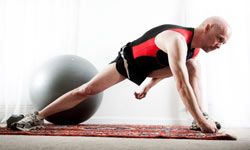If you're a guy, you probably know that men tend to view working out as a sport, and generally are pretty competitive when it comes to fitness. But they're also less likely than women to work with trainers, enroll in beginner fitness classes or even seek advice about training [source: Sorgen]. This drive to push your workout limits without proper preparation or taking the necessary precautions could result in safety risks that lead to injuries -- particularly when you're working out at home without supervision from fitness instructors. And that can be a major setback in your overall fitness plan.
Working out at home is a convenient way to stay in shape without the hassle of making it to the gym every day. But especially if you have the tendency to overdo it while exercising, it's important to take a few extra steps to make sure you don't end up hurt. Read on to learn five tips that can make your home workout a little safer.
Advertisement

